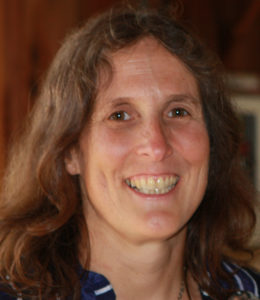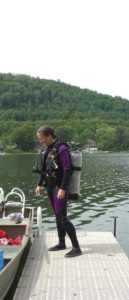By: Abby Bezrutczyk
Dr. Kimberly Schulz of SUNY ESF is protecting New York’s “amazing lakes” from invasive species by studying the invasion pathway of small boats, and the impact of those aquatic invasives on the system. NYISRI is pleased to spotlight her group’s important research in limnology and invasion ecology.

What kinds of research questions related to invasive species are you currently asking?
Currently our lab group is working in two main areas related to invasive species. First, we are investigating the role of small recreational watercraft in spreading invasive species among lakes, by quantifying the species and diversity of the organisms (invertebrates and plants) being moved from lake to lake in and on small boats. Second, we are measuring and modeling the effects of some established invaders on lake systems, focusing on several aquatic plants, plankton species and mussels. We are estimating effects such as changes in nutrient cycling, oxygen concentrations, and diversity of native species in the lakes they have invaded.
What are the basic methods you are using to answer your research questions?
We are using a combination of methods. These include field measurements, such as sampling organisms found on and in recreational vehicles, and mapping the distributions of the invasive species. Also, we are making field measurements of nutrients and other chemical and physical conditions in areas with and without invaders, as well as in patches dominated by native versus non-native species. We should be back in the lab soon (with social distancing!) running experiments to test the mechanisms behind the field patterns we see, such as how one invasive species might displace a native species, or affect the lake in another way (like increasing nutrients).
 Do you have a personal story or path that led to your interest in this research?
Do you have a personal story or path that led to your interest in this research?
I was always the kid who was always the first to jump into a lake or ocean and I went to college to become a marine biologist. I returned from a semester of open ocean research and took a class called Limnology, which I had never heard of before! Limnology is the study of inland waters, like lakes and ponds. The professor, Nelson Hairston, Jr. was fantastic. I realized that lakes are important, and how the physical, chemical and biological parts of the lake interconnect and are testable and predictable.
Applying research to management and remediation is more possible in lakes than in the ocean. By that I mean that, for a small team of scientists, a lake ecosystem– while complicated– is easier to figure out than is the whole ocean. Also, we have lots of lakes that are basically test systems with different conditions (like depth, nutrient concentrations, or fish species) that help us understand what is causing differences among lakes. Lakes are easier than the ocean to help remediate and conserve, because the smaller group of stakeholders living around a lake can make a big difference in successful lake management, compared to in the ocean, where the whole giant ocean is interconnected.
During my time as an undergraduate, I saw firsthand the effects of the invasion of Eurasian watermilfoil while working with Robert Johnson, who was developing biocontrol methods. In graduate school, I was doing work on plankton and nutrients on the Great Lakes when the spiny water flea invaded, and I realized then that invasive species were really a major problem for the natural functioning of our lakes. Working on invasive species has been part of what I do since those early days.
How does your research relate to the wider field of invasive species prevention/management?
Generally, our research is more on the ecological research end of invasive species science, but I think it’s important to team up with people doing hands-on management. That makes it so the research is directly informing technology and management recommendations to reduce the negative impacts of all these invasive species and to reduce their spread. For example, when the fish hook flea first arrived in NY, a MS student in my lab, Michael Snyder, ran experiments to see what treatments can kill the dispersal stages of fish hook fleas safely, and prevent them from reaching new lakes; we worked with NY Sea Grant on a factsheet to popularize that. Our work with NYS Parks and the Watercraft Inspection Steward Program to see what is actually traveling in the bilge water is also geared toward informing recommendations to boaters to prevent the spread of invasive species. We hope our work will help scientists and managers develop methods to moderate or reverse the negative effects on native species and habitats.
What’s the most important thing about your research for managers and policy makers to know?
It’s much easier to prevent invasive species than to try to fix the problems they create after they arrive. Many of the problems they create for our aquatic resources are unanticipated and expensive to control – like huge expenses to reduce the nuisance mats of invasive plants in lakes that impede swimming and boating. Managers and policy makers can help by implementing policies that reduce the likelihood of spread of new invasive species and with programs to educate the public. Some people think that the invasive species that have been here for decades, like Eurasian milfoil or zebra mussels, are in all lakes. Policy makers might want to think of lakes as islands of water in the middle of an ocean of land. A lot of those islands remain pretty pristine and are refuges for some of our native species that have been lost to or diminished in other lakes due to negative effects of invasive species. It’s really important to keep supporting efforts to prevent those lakes from being invaded as well. That will protect those more pristine lakes, as well as potentially provide sources to reintroduce native species if and when we are able to control or eliminate the invaders from other lakes.
What do you hope the long-term impact of your work will be?
I hope that our work will help scientists to better understand how these invaders spread and affect lake ecosystems, and that this basic science then will continue to allow us to work creatively with other scientists, policy makers, managers and engineers not only to prevent further spread of invasive species, but also to manage and reduce their impact on the amazing lakes we have in New York, as well as other lakes around the world.

